Battle of Okinawa. Japan invasion plans
Back in the course of the battle for the Philippines, the American command began preparing new operations against Japan. The Joint Chiefs of Staff set the following tasks for the armed forces in the Pacific: take up positions on the Nampo and Ryukyu Islands in order to get additional airfields for attacks on metropolitan islands; complete the blockade of Japan from the sea and from the air; maintain military pressure on Japan. The solution of these problems was begun with the seizure of the island of Iwo Jima, located halfway from Japan to the Mariana Islands.
The island of Iwo Jima, the size of which exceeded 5 by 8,5 km, was not considered by the Japanese command as a strategic object, so its defense was relatively weak. On the island there were 23 thousand garrison with 23 tanks and 600 guns. There was almost no air cover - only a few aircraft. The maritime component was also minimal - several small submarines and a dozen patrolmen.
The US-British command still used the strategy of concentrating the maximum possible forces on a narrow sector, which would crush the enemy with one crushing blow. The landing force was 110 thousand people. They were supported by a real air and sea armada: 352 aircraft of the air armies, 1170 aircraft, which were based on aircraft carriers, 5-th American fleet, the number of personnel which reached 220 thousand people.
As in previous operations, the Americans spent a long and powerful aviation and artillery training. Massive air strikes were carried out for 70 days! On February 19, they landed. In this case, the bombed Japanese on the coast almost did not show resistance. However, then the offensive developed extremely slowly. The Americans acted slowly. And the Japanese in the depths of the island put up stubborn resistance, skillfully using natural caves and specially created shelters for defense. However, superiority in the strength and technical means of struggle once again predetermined the victory of the Americans. By March 17, 1945, the Japanese garrison was destroyed.
Japanese troops almost completely died in the capture war and captured only 200 people (later, when they finished off the remnants of the Japanese troops, they captured even more 800 people). Americans lost more people than the Japanese, about 26 thousand people killed, wounded and missing. The battle for Iwo Jim was the bloodiest in stories US Marine Corps. The US Navy has lost 18 ships, mainly due to air strikes and coastal artillery fire.
The US command set up a military base on Iwo Jima. 10 March US Air Force bombed Tokyo, 12 March - Nagoya, 13 March - Osaki. These air raids from the island have become regular. The Iwo Jima base, along with the strongholds on the Aleutian Islands, gave the United States the ability to control the northwest Pacific.
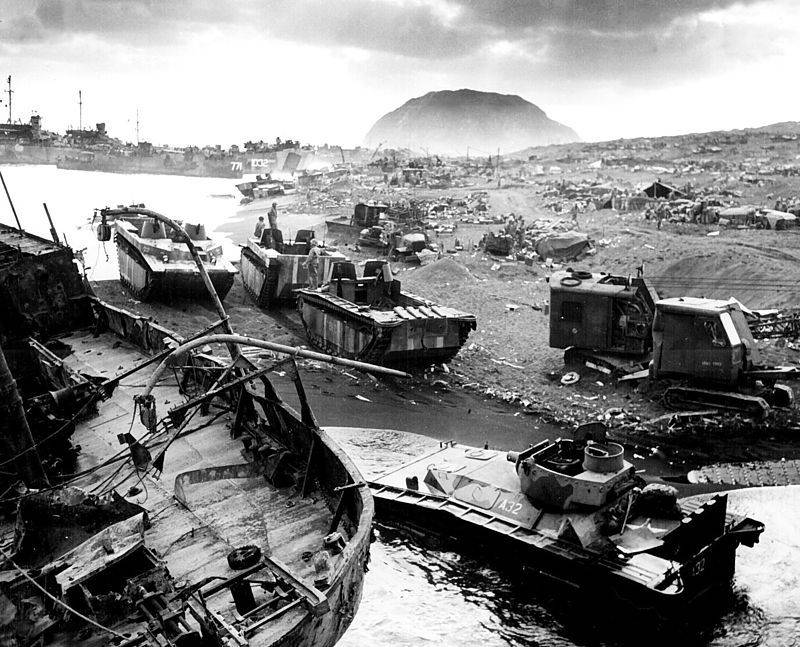
American technology, burned in the first days of the fighting on Iwo Jima
Simultaneously with the fighting on Iwo Jima, the Americans prepared an operation to seize Okinawa. This island was of particular importance in the American plans. Its strategic position ensured domination not only in the East China Sea, but also made it possible to threaten Japan itself. In addition, Okinawa interested Americans as a future large military base in the western Pacific. The island has convenient sites for the construction of airfields and naval structures.
The Japanese command also attached great importance to Okinawa. Island defended 70-thousand. 32-I Japanese army and about 9 thousand. Sailors. In addition, the entire population of the island’s men, ranging in age from 17 to 45 years, was mobilized into the army. Even schoolchildren were used as attendants. The 32 th army supported from the air 5 th air fleet, which has about 250 aircraft. In the course of the defense of the island, it was supposed to strengthen the 5 th air fleet by airplanes from other air fleets, including shells with suicide pilots. Took part in the defense of the island in the Japanese Navy: 1 battleship, 1 light cruiser and 8 destroyers.
The task of assaulting Okinawa was entrusted to the 10th American Army under the command of General Simon Bolivar Buckner Jr., which was formed in early 1945. The army had two corps: the 3rd corps consisted of the 1st and 6th divisions of the marine corps, the 24th corps included the 7th and 96th infantry divisions. The US 2nd Marine Division remained in reserve. In addition, under the command of the 10th Army were the 27th and 77th Infantry Divisions. In total, under the command of the 10th Army there were more than 100 thousand soldiers of the US Army, 88 thousand people of the Marine Corps and 18 thousand people from fleet. The American army was reinforced with 300 amphibious tanks, a large number of artillery, mortar, engineering and other units.
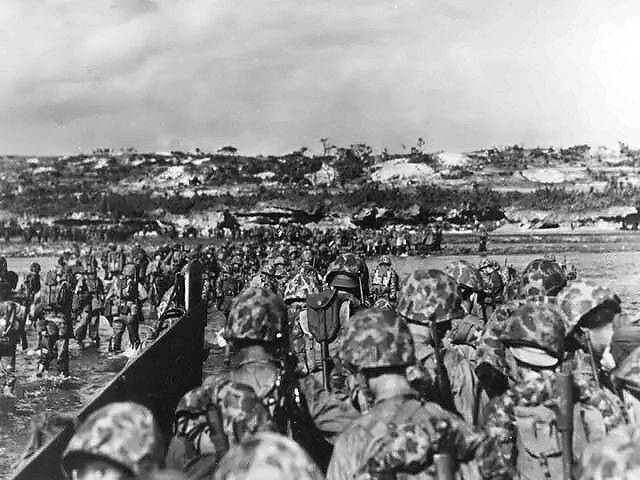
Americans land in Okinawa
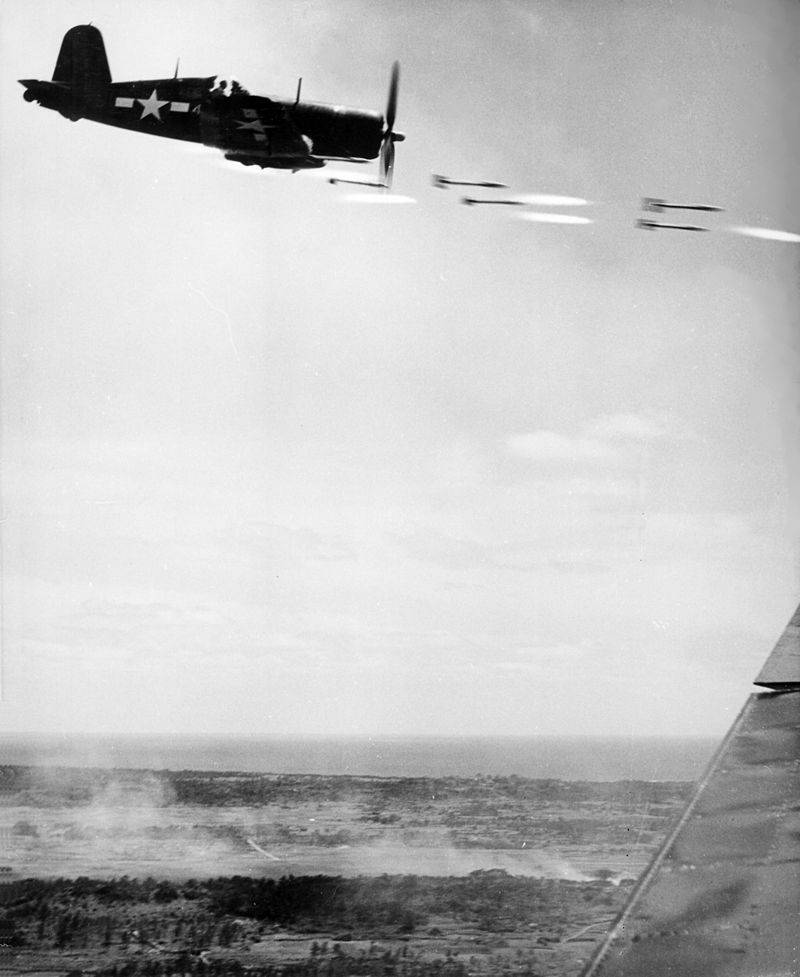
F4U Corsair supports US forces on the island with rocket fire on enemy positions
The landing was supported by the American fleet 5 and the British aircraft carrier, which had a total of more than 1300 warships and auxiliary vessels. In the combat core of the naval component of the strike force were 20 battleships, 33 aircraft carrier, 32 cruisers, 83 destroyers and 36 submarines. On aircraft carriers located more than 1700 aircraft. To enhance the aviation component, strategic air force aviation was involved. The total number of American groups was more than 450 thousand people. The US-British command created overwhelming superiority in all branches of the armed forces.
The operation was prepared for a long time: from January to April, 1945 g. During this period, American aerial reconnaissance revealed the defensive grouping of the Japanese on the island and its defense system. In early March, the 1945 of the US Air Force launched massive strikes against the airfields and naval bases of Japan, located in the area of the Ryukyu Islands. 18-19 in March, the Americans bombed airfields on the islands of Kyushu, Shikoku and in the southern part of Honshu. Since 23 March, air strikes have been carried out on Okinawa itself. At the same time, ship artillery shelled the coast. 26-29 March US forces captured a group of Kerama Island, located west of Okinawa. On these islands was established ship parking and logistics base.
The landing operation on Okinawa’s west coast began on 1 on April 1945. Marines landed under the cover of several dozen battleships, cruisers and destroyers. Initially, the resistance of the Japanese troops, who were waiting for the enemy to land on the east coast, was weak. Therefore, the Americans on the first day easily occupied a bridgehead to 14 km along the front and to 4 km in depth. The next three days, the Americans went to the east coast and cut the Japanese group into two isolated parts.
Under the threat of losing the island, the Japanese command tried to launch a counterstrike in order to disrupt the enemy’s landing operation. For this purpose, suicide attacks and naval forces were used. April 6 began the attack of the Japanese Air Force. On the same day, the Japanese ships sailed from the Sea of Japan and headed for Okinawa. A squadron of Japanese warships headed by the battleship Yamato was to strike the Allied fleet, auxiliary vessels, and in case of problems returning to the base, the battleship was ordered to break through the enemy fleet, stop at the coast and support the defenders of Okinawa with its artillery fire. The naval guns were to play the role of conventional artillery, and the crews of the ships - the role of marines. It was believed that the Yamato strike would distract the enemy, which would allow Japanese aircraft to strike hard at the allied fleet. In fact, it was a suicide attack plan, with no chance of winning. Perish, but take as many enemies as you can.
A strike on the Americans planned to inflict 8 April. However, the Japanese fleet could not secretly approach the intended target. The American submarines intercepted the broadcasts of the Japanese ships, and the enemy’s plan became clear. On the morning of April 7, American bombers and torpedo bombers based on aircraft carriers attacked the enemy in the area south of Kyushu. The battleship Yamato, the cruiser and 4 destroyer were killed. More than 3 thousand people died at Yamato alone. The remaining ships, having received damage, retreated to their bases.
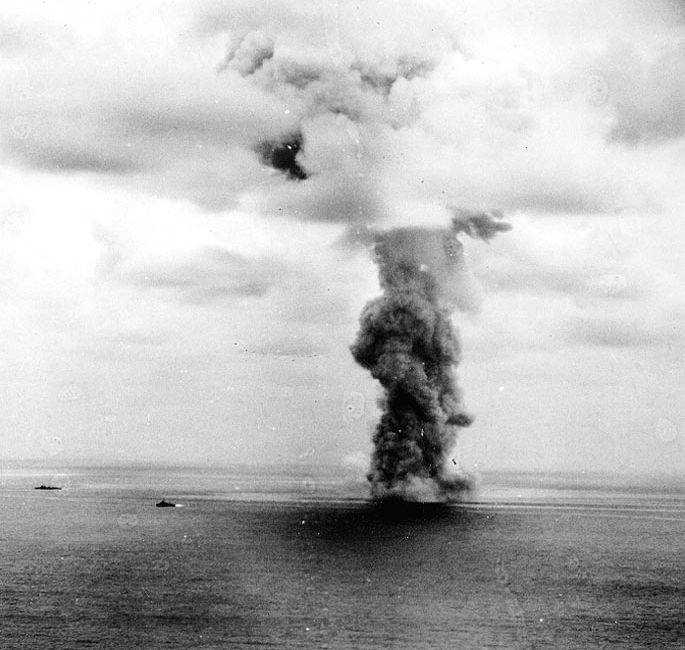
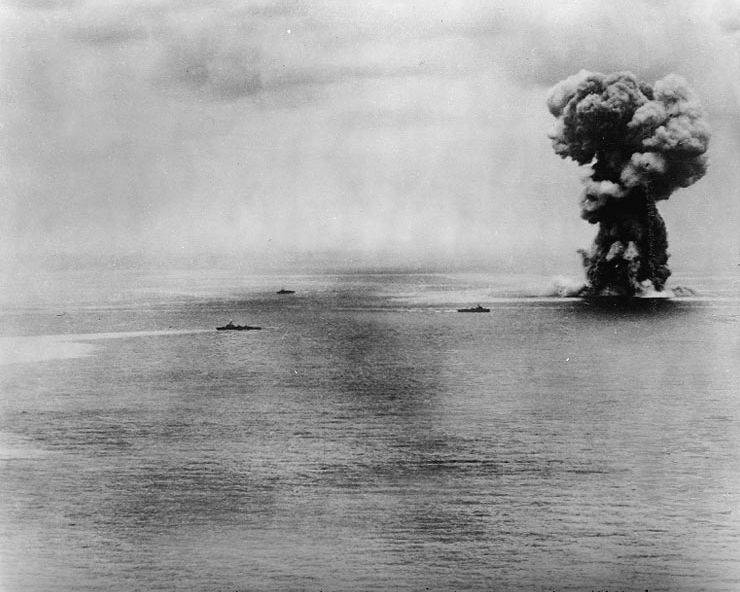
The battleship "Yamato" explodes from damage caused by raids of American aircraft
The Japanese Air Force acted more successfully. During the nearly three-month battle of Okinawa (from 1 April to 22 June 1945), the Japanese were able to sink 22 and seriously damage the 164 of the American ship. However, the attacks of the Japanese air force could not disrupt the landing operation. By 22 on April 1945, the American forces cleared the northern part of the island from the enemy. The battle for the southern part of the island was prolonged. Here the main forces of the Japanese army kept the defense. The Japanese soldiers skillfully used the rugged terrain (caves, ravines, rocks) and prepared the system of engineering structures well. In order to break the desperate resistance of the Japanese, the Americans had to exert all their forces and means. Only after fierce fighting, the Japanese were destroyed. By the end of 21 on June 1945, organized resistance on the island was crushed.
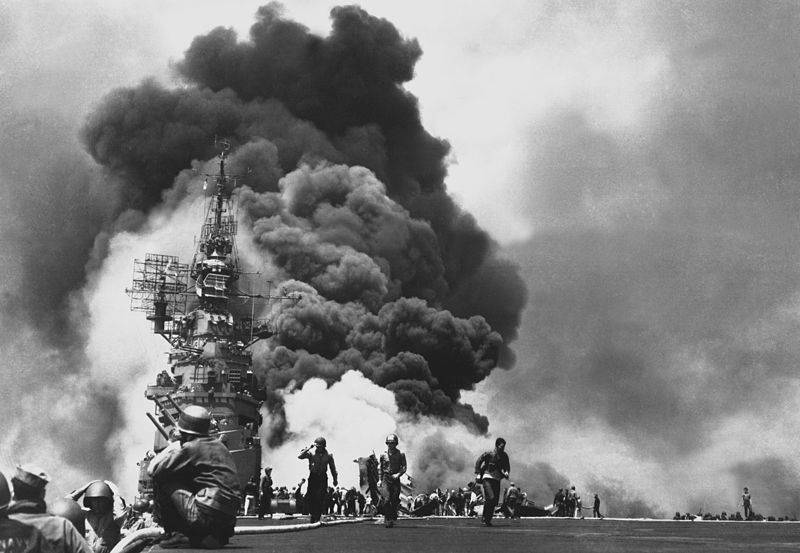
Fire on the Banker Hill aircraft carrier after two Japanese kamikaze attacks
During the battle for Okinawa, the Americans suffered heavy losses - more than 75 thousand people were killed, wounded and missing (according to other sources - about 50 thousand people). At the same time, more than 10 thousand US military were demobilized due to nervous breakdowns. As a result, the battle for Okinawa became the bloodiest battle for the American army throughout the Pacific theater of operations and the second in terms of casualties in the entire war, second only to the Ardennes operation in terms of casualties. In battles on the island itself, the Americans lost 225 tanks and a lot of amphibious tracked amphibious vehicles. The fleet lost 36 ships dead, another 368 ships and auxiliary ships were damaged. Aviation lost 763 aircraft.
Japanese losses amounted to about 100 thousand people killed and more than 7 thousand prisoners (ground forces, air force and navy). In addition, approximately 42, thousands of local residents (according to other data from 100 to 150, thousand people) became victims of the war. The Japanese lost 16 ships and ships, including the battleship and cruiser, and a large number of aircraft, mostly with suicide pilots.
Capturing the island was strategic. The allied fleet and the army, as well as aviation, received a military base in close proximity to the main part of Japan. On the captured island, the United States Civil Administration on the Ryukyu Islands was established, essentially a military government that existed on the island of 1972 of the year. Okinawa is still the largest US military stronghold in Asia.
Map Source: History of the Second World War 1939 -1945. In twelve volumes. M., 1973
Japan is preparing for the final battle
The exit of the enemy to the close approaches to Japan itself forced the Japanese military-political leadership to speed up efforts to prepare for the conduct of hostilities in the metropolis and on the mainland. In Northeast China, a total mobilization of all Japanese was carried out, which made it possible in the summer to form a number of new units and divisions. By this time, the third phase of mobilization was completed in the metropolis itself. The Chinese and Koreans living in Japan were drafted into the army. In the occupied territories of Korea and China, the number of troops of puppet governments has increased.
As a result of the measures taken, the ground forces of the Japanese armed forces grew to 4,6 million, and by the end of the year they were planned to increase to 5 million soldiers. Of the total number of Japanese ground forces, about 2 million soldiers were in Japan itself. The metropolis was ready to defend about 8 thousand aircraft of various types. In addition, there were about 1,6 million sailors in the bases and ports of Japan. The fleet was of immense importance in Japan, but now it has almost lost its previous role, and hundreds of thousands of seamen are now preparing for land battles. The remnants of the Japanese fleet — the 5 battleships, the 4 aircraft carrier, the 6 cruisers, the 24 destroyers, and other ships — were concentrated on bases in Japan.
The authorities were going to involve the entire nation in the struggle. Through the press, radio and cinema, the Japanese were assured of the need "to defend the foundations of the national state system, leading the war to the bitter end, drawing strength from the principle of eternal devotion to the emperor." 25 April 1945 was issued a special "Guide for the population on the conduct of defensive battles." According to him, detachments of a civilian volunteer corps were formed everywhere, which were to participate in combat operations along with the army. 22 June 1945, the Japanese parliament passed a law on voluntary army service. Under this law, for military service, "if necessary," men aged from 15 to 60 years and women from 17 to 40 years could be encouraged. In the combat units of the civilian corps could enroll, regardless of the consent and marital status.
The Japanese authorities intended to use all Japanese, if necessary, including women, teenagers and old people. At the same time, the Japanese emperor and the main headquarters were going to secretly hide in the huge underground fortress in Matsushiro. There, in case of the invasion of Japan by enemy forces, a network of underground tunnels was prepared. And in the case of the fall of Japan, the Japanese military-political leadership was going to flee to the mainland and continue resistance there by the forces of the Kwantung Army and the expeditionary forces that were stationed in China.
At the end of March 1945, a plan was made for a “decisive battle in Japan” (“Katsu”). He set the task of strengthening the areas of possible invasion with all the available forces, as well as entrances to the most important straits and bays of Japan; the mobilization and concentration of all mobile forces, especially aviation and suicide squads, who were supposed to attack the enemy assault forces at sea and at their approach to the coast; taking all measures to strengthen the country's air defense. One of the main goals of the Katsu plan was to "use the concentrated power of all forces to crush the advancing forces of the Americans ...".
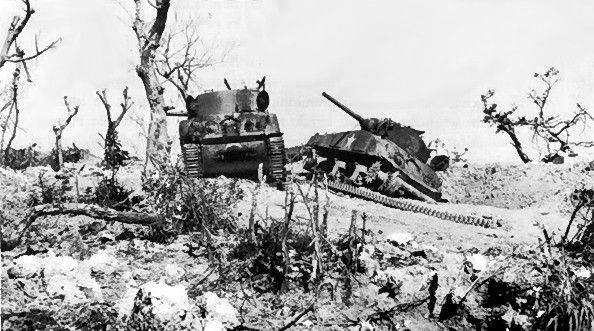
American Sherman tanks hit Okinawa
Invasion Plans for the Japanese Islands
Meanwhile, while Japan was preparing for the battle for the metropolis, the US-British command was developing plans for an invasion of the Japanese islands. Shortly after the capitulation of Hitler's Germany, the Joint Chiefs of Staff approved a plan for the landing of troops of the 6 US Army on Kyushu Island (Operation Olympic), with the support of all the air and naval forces in the Pacific. Beginning operations scheduled for November 1 1945. Four months later, that is, in the spring of 1946, the 8 and 10 American armies were scheduled to land on the island of Honshu (Operation Coronet). In the future, it was supposed to throw into battle 1 th US Army, for which it was necessary to transfer it to the Pacific from Western Europe. The main objective of the two operations was the destruction of the Japanese troops in their own territory, the seizure of the Tokyo-Yokohama area. Then they planned to advance north in order to capture the remaining Japanese islands.
At the same time, the headquarters of the Supreme Commander of Allied Forces in the Pacific, MacArthur, in the event of Japan’s surrender, developed the Blacklist plan. According to it, the 6-I American army was to occupy the islands of Kyushu, Shikoku and the western part of Honshu, the 8-I American army - the island of Hokkaido and the northern part of Honshu, the 10-I army - the Korean Peninsula. The occupation troops had to solve the following tasks: to occupy strategic centers; isolate Japan from Asia; to establish control over the highest governmental bodies; demobilize the Japanese armed forces; crush all elements that resist occupation.
However, the Americans did not count too much on the rapid end of the war. US Secretary of War Stimson, in a memorandum to Truman from 2 on July 1945, noted that “... operations to master Japan can be lengthy and require high costs and a bitter struggle on our part ... Having started the battle, we will have to finish it even more violent battles than those that took place in Germany. As a result, we will suffer huge losses and will be forced to leave Japan. ” Not counting on a quick victory and the British leadership. British Prime Minister Churchill, speaking in the House of Commons, said that it was impossible to “know how long the crackdown on Japan’s resistance would go on in the numerous territories it conquered, and especially in Japan itself”.
Thus, the American and British leadership did not expect a quick victory in Japan. Already the bloody battle for Okinawa showed the determination of the Japanese to resist to the last soldier. The battle for Japan could be delayed and lead to huge casualties on both sides. And the bombing of Japanese cities would only have multiplied the casualties among the civilian population of the Japanese islands.
While plans were being developed to invade the US-British forces in Japan, the fighting in the Pacific Theater was limited to the bombing of Japanese cities and the shelling of ship artillery of some objects on the east coast of the metropolis. For cruising operations, the American and British connections of high-speed ships — 18 aircraft carriers with 1246 aircraft, 9 battleships, 21 cruiser and 74 destroyer — were allocated. Between July and August, 1945 was bombarded and bombarded by Japanese cities, including Tokyo, around 60. As a result of these blows, civilians, who had almost no means of defense, suffered particularly heavy losses. Military facilities were covered by air defense, a high-ranking military-political leadership and the military had bomb shelters.
As a result, in the course of the fighting in the first half of 1945, the United States and Great Britain won a number of important victories over the Japanese forces in the Pacific and Southeast Asia. US-British troops won in the Philippines, Burma, captured a number of islands, including Okinawa, coming to the near approaches to Japan itself. The preparation of the invasion of the Japanese islands began. Sea communications of the Japanese Empire with the South Seas zone were completely intercepted. The supply of strategic raw materials from the countries of Southeast Asia, primarily oil and oil products, was completely disrupted. The Japanese naval and merchant fleets, due to heavy losses and lack of fuel, were almost completely shut off from the battle at sea. Numerous naval contingent began to prepare to fight on land. Irreparable damage suffered and Japanese aircraft. The Japanese economy was in severe decline, although it was also able to arm the ground forces. The Japanese leadership was preparing for a decisive battle for the territory of Japan itself.
However, the war could still drag on. The Japanese empire still had good chances to prolong the war, although this led to the enormous sacrifices of the Japanese nation. The Japanese military-political leadership, not without reason, hoped to organize fierce and long-lasting resistance on the Japanese islands, and then in Asia. For this, the Japanese government had powerful and numerous ground forces with a disciplined officer corps and fanatical soldiers, thousands of suicide bombers; obedient population, that is, a calm rear; great human resources that were willing to donate; the industrial base and resources of Japan and Northeast China; large territories, including Japan itself, the Korean Peninsula, a large part of China, and territories in Indochina.
Under these conditions, for the further course of the Second World War, the upcoming performance of the Soviet Union against Japan acquired crucial importance.
To be continued ...
- Alexander Samsonov
- The Soviet Union saved the world from "a decisive battle in Japan"
US offensive in the Pacific and Southeast Asia on 1945
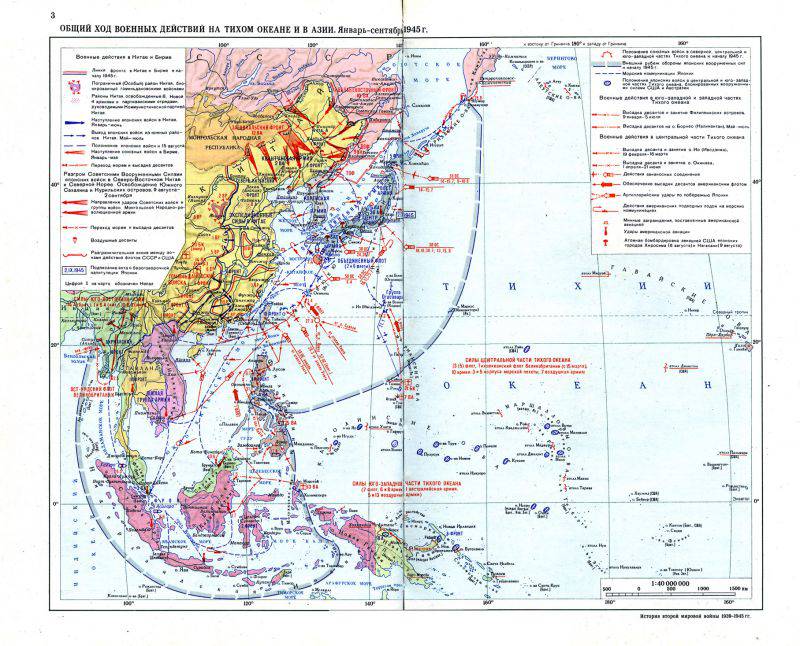
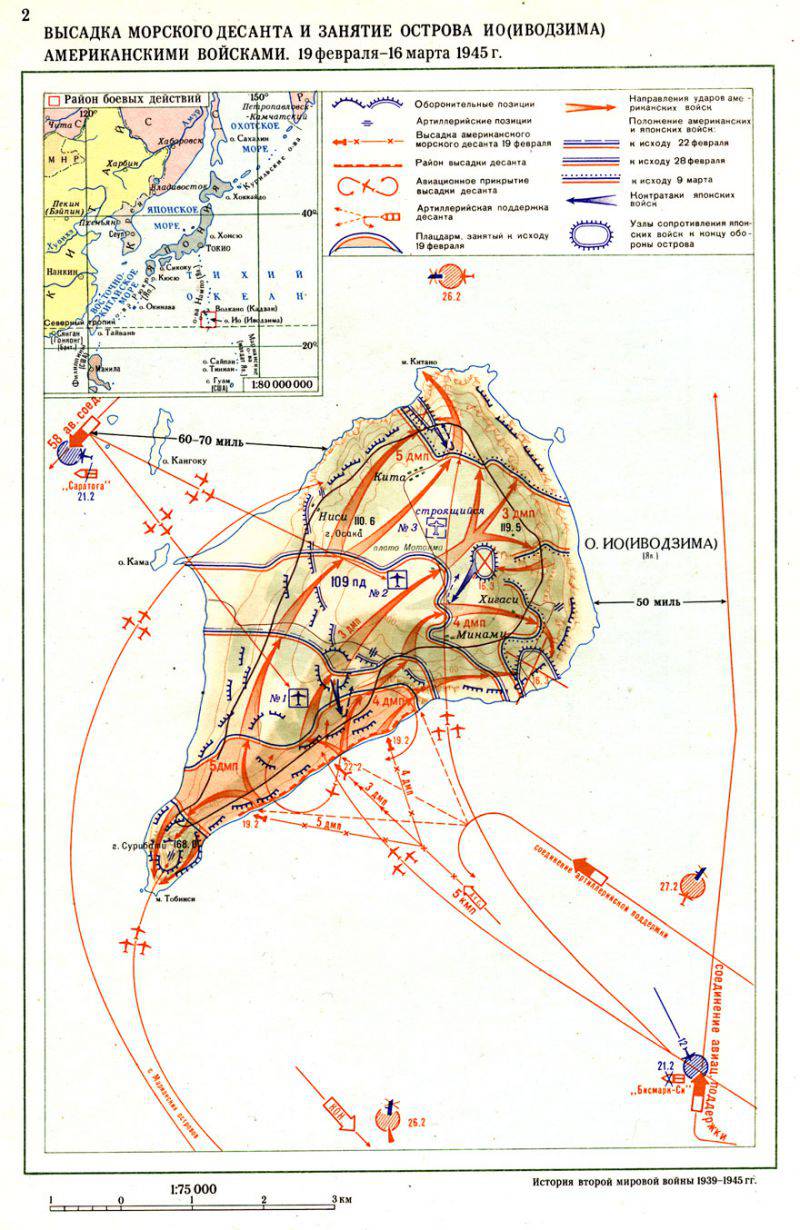
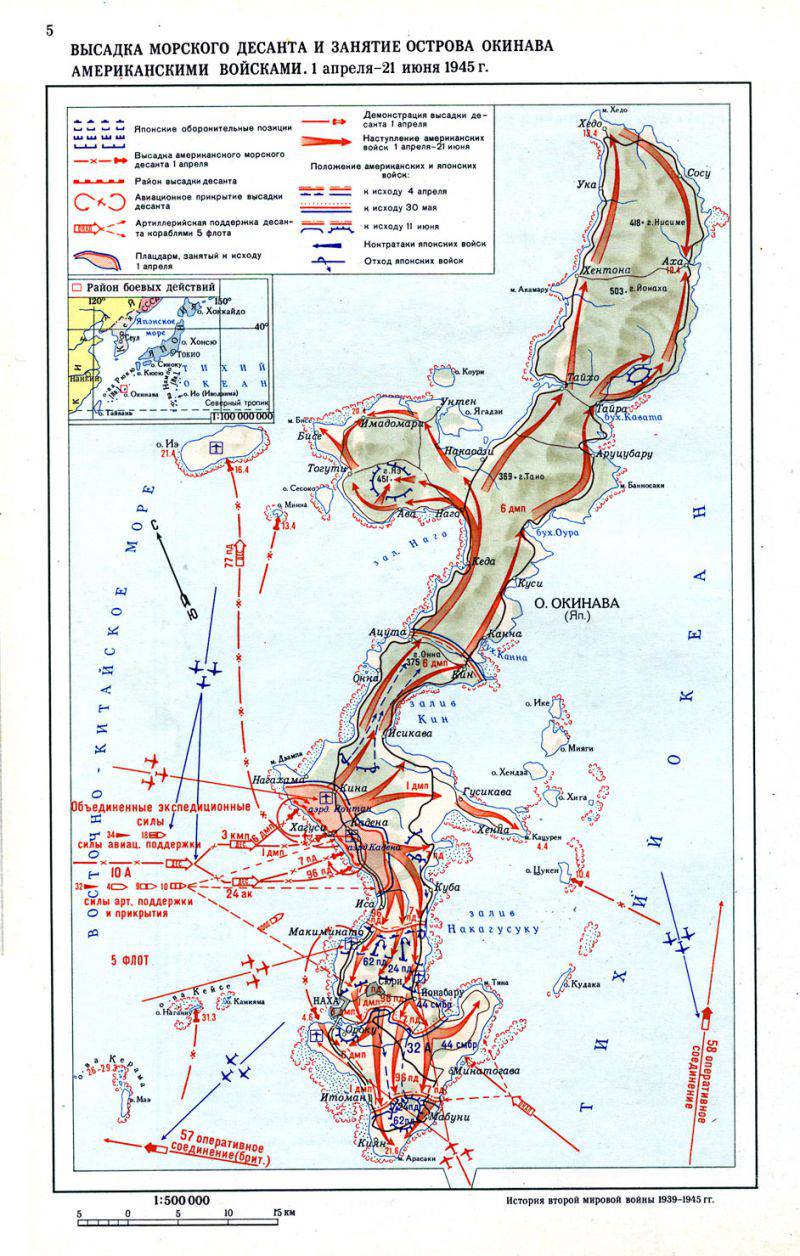
Information